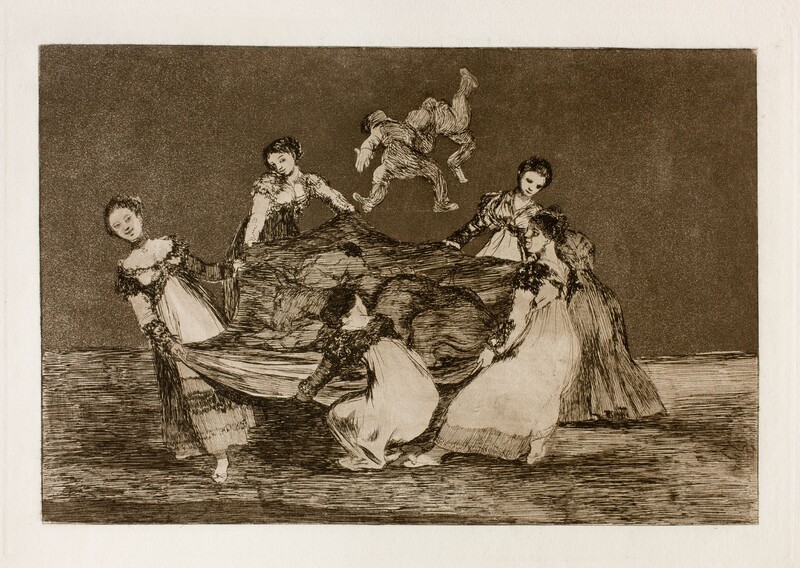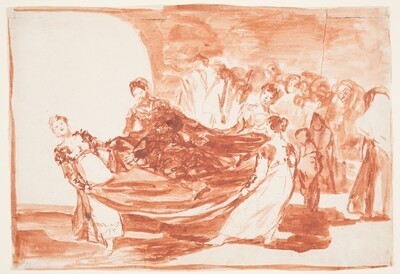- Cronología
- 1815 - 1819
- Dimensiones
- 247 x 359 mm
- Técnica y soporte
- Aguafuerte, aguatinta y punta seca
- Reconocimiento de la autoría de Goya
- Documented work
- Ficha: realización/revisión
- 21 Aug 2021 / 05 Jun 2023
- Inventario
- -
The date of production of the series of engravings of the Disparates has been much debated, but it can only be guessed that it was executed between 1815 and 1819. After Goya's departure for Bordeaux in 1824, the series (or, in other words, the copperplates of the various prints in it) fell into oblivion until the painter's death, when the plates passed to his son Javier Goya. After his death in 1854 they were acquired by Román Sarreta, who in turn sold them to Jaime Machén. He contacted the Ministry of Public Works in 1856 to find out if the State would be interested in acquiring the coppers of the Disasters (Sad forebodings of what is to happen) and the Follies. It seems that his reponse was negative, as they returned to their owner until 1862, when he offered them to the Royal Academy of Fine Arts of San Fernando, which acquired them for some 28,000 reales. The Disparates had never been published before, until the Academy released the 18 prints of the series in 1864.
A few years later, in 1877, four unpublished prints from the series were published in the Paris magazine L´Art, the copperplates of which belonged to the painter Eugenio Lucas. From each of the plates used to illustrate the magazine, four different prints were obtained on different types of paper and ink. After their publication, they became the property of Monsieur Leroi, who sold them in 1907 to Monsieur Gagot, from whom they were inherited by his daughter, the present owner, Madame Le Garrec.
Thus, the 18 prints that made up the series were reduced to 22, although it is quite likely that Goya had conceived more, leaving the series incomplete. This is because a state proof of Unrestrained Folly (Kidnapping horse) was found with the number 25, handwritten, and another of A way of flying with the number 34.
Regarding the first of the prints in this series, there is a known aquatint proof in the Lázaro Galdiano Fundation in Madrid, with the manuscript numbers 15 and 16 and the handwritten caption that gives it its title: Feminine folly. Another proof, preserved in the Pereire collection, has the manuscript: "With donkeys you can play with buckskins."
The series originally had no name until its publication by the Royal Academy of San Fernando in 1864, when it appeared under the name of Proverbs, as it was believed that the prints could be illustrations of proverbs or sayings. Over time this justification has been proved wrong, so this name is not the most appropriate. The one that comes closest to Goya's intentions is The Follies, as it is the word that appears repeated in the handwritten signs, by Goya himself, in some of the state proofs. It is also known as Dreams, a name that fits in well with the fantastic and dreamlike nature of the series, but as it is a name commonly used by Goya, it is not the most appropriate.
Unlike other series, this one does not have a specific order. In the Academy edition one was arranged, but in a completely arbitrary manner. It was not until state proofs began to appear that a possible orfer devised by Goya began to be discerned, as some of them had manuscript, in adition to a possible title, numbering in the upper roght-hand corner, left-hand corner or both, which, moreover, do not coincide in order, so the problem of the sequencing of the prints continues to exist.
But this series contains an even more important enigma: that of its meaning. The mysterious nature of the scenes and the lack of contemporary commentary have made it almost impossible to discern the meaning of the prints. Nevertheless, many interpretations have been made of the series: it has been read as a social critique and satire of political events, as an allusion to different sayings, or as a continuation of the Caprichos (Francisco de Goya y Lucientes, Painter). The most widely accepted seems to be that initiated by Ramón Gómez de la Serna and developed by authors such as Nigel Glendinning, who relates the prints to carnival traditions. Customs of this type appear, such as the manteamiento, the masks, the grotesque figures and the Aragonese tradition of the giants and big-heads. In addition, the proof of the state of one of the prints bears the legend Carnaval folly. Also typical of Carnival is the criticism of authority and society, such as the military, the clergy and the institution of marriage.
The Follies is a disconcerting and disturbing series, so that any search for an explanation seems fruitless. Everything resists an acceptable interpretation. A deranged world is represented to us in which that is not shown, that which is only glimpsed, is revealed. The monsters of our imbalance and unreason are graphically exposed. That is why the scenes are full of distorted or deformed characters, zoomorphic or semi-human figures, ghosts, limbs and animals. The envieroment is a absent, with a predominance of flat, abstract aquatint backgrounds in which the figures move in darkness or chiaroscuro. There are hardly any scenes in full light or indoors. A sense of darkness is evident in the chaos of perspectival angles and the arbitrary proportions. The compositions are reminiscent of the Black Paintings (The Leocadia), with depersonified masses. All this, together with the lack of information, the lack of order and the lack of titles, makes it difficult to understand the series.
It is a late-period work, so it is full of memories, allusions and ideas taken by Goya from his life and work, such as the tapestry cartoons, The Caprices, the war, his illness... However, in it Goya breaks with the Enlightenment: he replaces reason with metaphysics in a language that connects with Flaxman, Füssli and Blake and brings him closer to Romanticism.
The prints are made using the etching technique, with which he traces the design of the composition on the copper plate, and the aquatint technique, sometimes burnished, with which he creates luminous and volumetric effects. The burin and drypoint are used for retouching.
The first of the prints in The Follies series depicts six women chasing men and a donkey. A similar scene was depicted by Goya in 1791 in one of his tapestry cartoons, The Wimp. In this case he reworked the subject, moving from the smiling and optimistic tone of the painting to the disturbing tone of the print. Gone is the fun game in which a group of young girls entertain themserves by shaking a dummy. Now the innocent game has been transformed into a male mockery. The wimpers fly through the air while the figure of a donkey remains on the blanket, the mass of which is confused with that of another muppet. The donkey is an enigmatic figure, but it seems to be an element that accentuates male stupidity, as men are easily mocked by women. In fact, the man is presented as the victim of femenine cunning and coquetry, something already reflected by Goya in Caprice 19. They will all fall and Caprice 20: They are already plucked. The difference lies in the fact that in these caprices there was a satirical intention, whereas in the nonsense the criticism becomes metaphysical.
The girls are dressed as majas (young women) with epaulettes, with a distance and coldness in their expressions that makes the malignity of their intentions clear.
The characters are framed in an almost neutral or abstract space, delimited only by a horizon line.
The lighting is almost spectral, as the source of the light is unknown.
The preparatory drawing for the present print, also entitled Femenine Folly, has survived.
-
Goya: zeichnungen, radierungen, lithographienInternational TageIngelheim1966exhibition displayed from May 7th to June 5 th 1966
-
Etchings by Francosco GoyaJohannesburgoJohannesburgo1974
-
1976
-
Grabados de Goya: colección propiedad de la Biblioteca Nacional, que se conserva en su Gabinete deCasa de la Amistad de MoscúMoscow1979exhibition displayed from January 18th to 31st 1979
-
Goya. Das Zeitalter der Revolucionen. Kunst um 1800 (1980 – 1981)Hamburger KunsthalleHamburg1980cat. 146
-
Goya y el espíritu de la IlustraciónMuseo Nacional del PradoMadrid1988from October 6th to December 18th 1988. Exhibited also at Museum of Fine Arts, Boston, January 18th to March 26th 1989; The Metropolitan Museum of Art, Nueva York, May 9th to July 16th 1989, Madrid curator Manuela B. Mena Marqués, scientific directors Alfonso E. Pérez Sánchez and Eleanor A. Sayre
-
1989
-
Ydioma universal: Goya en la Biblioteca NacionalBiblioteca NacionalMadrid1996from September 19th to December 15th 1996cat. 302
-
Francisco Goya. Sein leben im spiegel der graphik. Fuendetodos 1746-1828 Bordeaux. 1746-1996Galerie KornfeldBern1996from November 21st 1996 to January 1997
-
Goya. 250 AniversarioMuseo Nacional del PradoMadrid1996consultant editor Juan J. Luna. From March 29th to June 2nd 1996
-
Goya grabadorMuseo del Grabado Español ContemporáneoMarbella1996from March 8th to May 5th 1996
-
Zaragoza1996
-
London1997
-
Madrid1999
-
Schlaf der Vernunft. Original radierungen von Francisco de GoyaMunich2000
-
Bilbao2012
-
Goya et la modernitéPinacothèque de ParisParís2013from October 11st 2013 to March 16th 2014cat. 201
-
Goya: Order and disorderMuseum of Fine ArtsBoston2014cat. 109
-
2022
-
BarcelonaInstituto Amatller de Arte Hispánico1951
-
OxfordBruno Cassirer1964pp. 372-373, cat. 248
-
Vie et ouvre de Francisco de GoyaParísOffice du livre1970p. 325, cat. 1571
-
MadridEdiciones Velázquez1974pp. 22-23
-
MadridTurner Libros, S.A1992
-
Catálogo de las estampas de Goya en la Biblioteca NacionalMadridMinisterio de Educación y Cultura, Biblioteca Nacional1996p. 235, cat. 374
-
MadridReal Academia de Bellas Artes de San Fernando y Calcografía Nacional1996pp. 101 y 109, cat. 1 y 21
-
Goya's prints: the Tomás Harris collection in the British MuseumLondonBritish Museum Publications1996pp. 77-83
-
Ydioma universal: Goya en la Biblioteca NacionalMadridBiblioteca Nacional, Sociedad Estatal Goya 96 y Lunwerg1996pp. 259-275
-
MadridConsejo Superior de Investigaciones Científicas2010pp. 478-480
-
ParísPinacoteca de París2013p. 270
-
Goya: Order & DisorderBostonMuseum of Fine Arts Boston Publications2014pp. 178-179
-
Goya. In the Norton Simon MuseumPasadenaNorton Simon Museum2016pp. 204-211
-
Museo de Bellas Artes de Badajoz y Diputación de Badajoz2022p. 91

